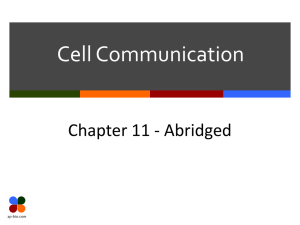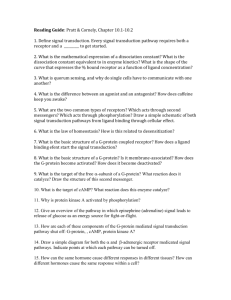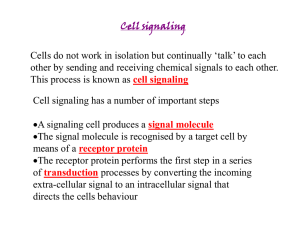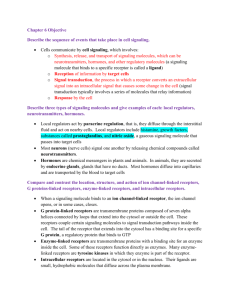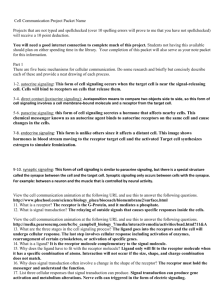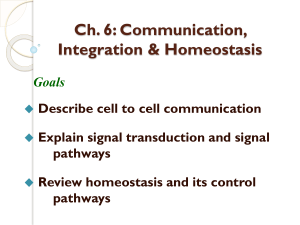CHAPTER 11 – CELL COMMUNICATION YOU MUST KNOW: How
advertisement
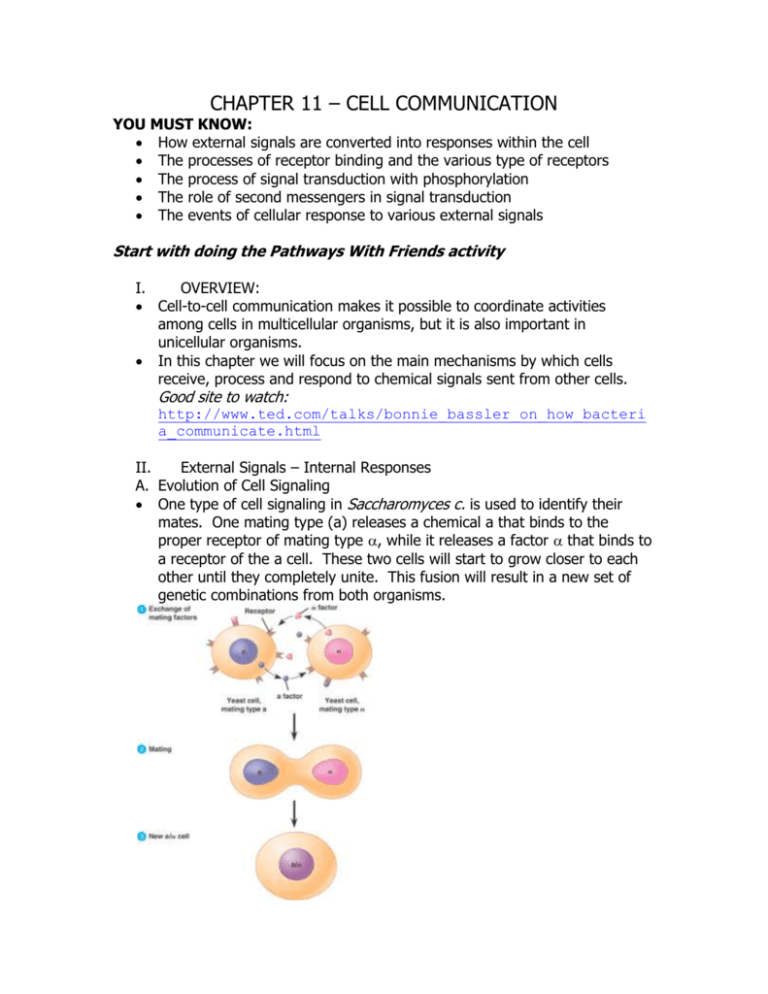
CHAPTER 11 – CELL COMMUNICATION YOU MUST KNOW: How external signals are converted into responses within the cell The processes of receptor binding and the various type of receptors The process of signal transduction with phosphorylation The role of second messengers in signal transduction The events of cellular response to various external signals Start with doing the Pathways With Friends activity I. OVERVIEW: Cell-to-cell communication makes it possible to coordinate activities among cells in multicellular organisms, but it is also important in unicellular organisms. In this chapter we will focus on the main mechanisms by which cells receive, process and respond to chemical signals sent from other cells. Good site to watch: http://www.ted.com/talks/bonnie_bassler_on_how_bacteri a_communicate.html II. External Signals – Internal Responses A. Evolution of Cell Signaling One type of cell signaling in Saccharomyces c. is used to identify their mates. One mating type (a) releases a chemical a that binds to the proper receptor of mating type , while it releases a factor that binds to a receptor of the a cell. These two cells will start to grow closer to each other until they completely unite. This fusion will result in a new set of genetic combinations from both organisms. Changes inside of cells can be brought on by a signal transduction pathway – the process by which a chemical signal on the surface of a cell is converted into a specific cellular response inside the cell. Molecular pathways of cell signaling are very similar in simple organisms such as yeast and in more complex organisms such as humans. This proves that these signaling mechanisms are very ancient and developed early in evolution. B. Local and Long-Distance Signaling Some signals directly affect neighboring cells (cell junctions and cell-cell recognition) – direct communication Local regulators – messenger molecules that are secreted by signal cells and travel only to short distances by diffusion. o Signals are released by certain cells and these cells are also the ones that respond back to the signal – autocrine signals o Numerous surrounding cells can receive these signals and respond to it. (Ex. Growth factors – make cells in the vicinity grow and multiply) In animals this local signaling is called paracrine signals. o Synaptic signaling – is also a local signal type but it occurs in the animal nervous system. An electrical signal travels along the nerve cell and triggers the release of specific chemicals called neurotransmitters. This signal travels across a gap (synapse) between the neighboring cells and stimulates the target cell. Long-distance signaling affects specific target cells that are far away in the body from the regulator cells. Examples: o Endocrine cells – hormone releasing cells that release hormones into the vessels of the circulatory system by which they travel to the target cells. Plant hormones frequently reach their target cells by moving from cell to cell or through the air or soil. o Transmission of nerve signals can also be considered longdistance signals when the long nerve cells carry the impulse to various parts of the body and converts the electric signal back to a chemical signal that crosses a synapse C. The Three Stages of Cell Signaling The entire signaling process – from the signal’s landing on a receptor to conveying a message to the cytoplasm, the cell’s final response is called a signal transduction pathway Reception – The target cell detects a signal molecule coming from outside of the cell. The signal molecule must bind to a receptor molecule on the cell’s surface or inside of the cell to be detected. The signal molecule usually changes the shape of the receptor. Transduction – The binding of the signal molecule changes the receptor protein and initiates the process of transduction – converting the signal to a useful form that will generate changes in the cell. Response – A responder is the next component of the signal transduction pathway. The responder is located inside of the cell and responds to a change in the receptor by changing shape, forming new bonds, releasing or binding with other molecules. The responder can also: Transfer phosphate groups from ATP to a target protein Amplify a signal Activate a transcription factor (a molecule that regulates mRNA transcription) Make a particular protein Alter the cell’s activity http://learn.genetics.utah.edu/content/begin/cells/cellcom/ III. SIGNAL RECEPTION A receptor protein on or in the target cell will be able to detect the signal molecule by a matching (complementary) shapes. The signal molecule acts as a ligand by specifically binding to a specific molecule. Ligand binding usually causes a receptor to undergo conformation (shape) change. This change usually directly activates the receptor to interact with other molecules inside the cell. In some instances receptor binding causes the aggregation of two or more receptors and causes further cellular changes. Most receptors are protein molecules. Their ligands are large watersoluble molecules that cannot pass through the cell membrane easily. However, some of the receptors are located inside the cell. A. Intracellular Receptors: Intracellular receptor proteins are found inside the cytoplasm or in the nucleus of the target cells. The signal molecules (ligands) in these cases must be able to pass through the cell membrane to reach the receptor. Signal molecules can do this by being hydrophobic or small to cross the phospholipids bilayer. Examples of ligands that can pass through the cell membrane includes steroids, thyroid, nitric oxide (NO). The signal-receptor complex is able to regulate gene expression by acting as a transcription factor that turns on specific genes. In cases of receptors that get into the nucleus, the receptor and ligand complex can carry out the entire reception and transduction process Many of the intracellular receptor proteins have similar structures that suggest their common evolutionary origin. B. Receptors in The Plasma Membrane: Water-soluble signal molecules bind to receptor molecules on the surface of the plasma membrane. These receptors have to change shape or aggregate to perform transduction. Three major types of membrane receptors and their function: G-protein-linked receptor: these receptors are located in the cytoplasm (integral proteins) and work with a G-protein (a group of proteins that are made up of 3 subunits and are able to bind with GTP and GDP). The G-protein has two important binding sites. One site binds with the G protein-linked receptor, the other binds with GDP in its inactive form and GTP, when the protein is activated. Many different signal molecules can use G-protein linked receptors (neurotransmitters, hormones such as epinephrine or yeast mating factors). Many bacteria cause diseases by producing toxins that intervene with G-protein function. These receptors work the following way: 1. The G-protein acts as a molecular switch which is either on or off, depending on which of the two guanine nucleotides is attached, GDP or GTP. When GDP is attached to the protein, the protein is inactive. 2. When a matching signal molecule binds to the receptor molecule, the receptor is activated and changes shape. The change in shape activates the G-protein, so it replaces its GDP with a GTP. 3. The activated G-protein dissociates from the receptor, moves to an enzyme and alters it. When the enzyme is activated, it triggers a cellular response. 4. The G protein changes back to its inactive form and returns to the receptor molecule. http://www.youtube.com/watch?v=bU4955rLv_8&feature=related Protein Kinase Receptors – Once these receptors get activated, they activate a group of enzymes, called protein kinases. Protein kinases catalyze the transfer of phosphate groups from ATP to a specific protein. This phosphorylation alter the shape of the target protein and activates it. A good example of a protein kinase receptor is an insulin receptor: o The insulin receptor binds with insulin that comes from the bloodstream. o The receptor changes its shape after binding. This shape change exposes the active site of a protein kinase in the cytoplasm. o Once the kinase is exposed, it phosphorylates several cytoplasmic proteins. o These proteins will expose a glucose transport protein to the surface of the cytoplasm to make the cell absorb more glucose and form glycogen from glucose in the cell. Abnormal receptor tyrosine kinases that function in the absence of signal molecules can contribute to some kinds of cancer. http://www.youtube.com/watch?v=-iBb1sH-Eh4 Ion channel receptors – a type of membrane receptors that can act as a gate when the receptor changes shape. When the signal molecule binds to the receptor protein, the gate opens or closes, allowing or blocking the transfer of specific ions such as Na+ or Ca2+. Each type of ion channel receptor has its ligand molecule (signal molecule) or another sensory signal such as light, sound, electric charge etc. (Ex. Acetylcholine receptors in nerve and muscle cells. These receptors open up when acetylcholine binds with them and allows Na+ ions to rush into the cell to generate a nerve signal or muscle contruction). IV. TRANSDUCTION OF SIGNALS The same signal can produce a different response in different cells. These responses are caused by the signal transduction. Signal transduction can be: i. Direct transduction – transduction directly occurs with the receptor on the plasma membrane ii. Indirect transduction – a more common way when another molecule called a second messenger mediates a further interaction between the receptor and the cell’s response. Insert 15.9 from Life book here. In both cases of transduction, a cascade of events is initiated by the signal. During this cascade, proteins interact with each other and/or change shape until the final responses are achieved. Through the cascade, a weak signal can be amplified, or distributed to cause several different changes in the target cell. A. Transduction with protein kinases Protein kinases for example act in direct transduction when the protein kinase receptors expose the kinase enzymes to phosphorylate other proteins. These are useful for creating cascades for the following reasons: i. At each step of the cascade, the signal is amplified, because the newly activated protein kinase is an enzyme which can catalyze the phosphorylation of many target proteins ii. The information that came from the original signal molecule can be communicated all the way to the nucleus iii. Depending on the presence of various enzymes, this response can become very specific. iv. Protein kinases can easily be deactivated by another enzyme called protein phosphatase that cuts off the phosphate group from the protein and deactivates it. B. Transduction with second messengers Many signaling pathways also involve small water-soluble molecules or ions – second messengers. These result in indirect signal transduction. Second messengers are molecules that are released into the cytoplasm after the first messenger (the signal) binds to its receptor. The second messenger affects many processes in the cell, so one single signal molecule can result in widespread changes in the cell. Second messenger can also amplify signals. Second messengers are nonprotein molecules, so they do not act as enzymes but act as cofactors or allosteric regulators of target enzymes. Different types of second messengers: o Cyclic AMP – An enzyme called adenylyl cyclase, is embedded in the plasma membrane to convert ATP to cAMP in response to an extracellular signal (ex. Epinephrine). When the signal molecule binds to a receptor, the receptor activates adenylyl cyclase to form many molecules of cAMP. This way one signal molecule can induce the synthesis of many cAMP molecules. The cAMP molecule usually activates a protein kinase molecule to phosphorylate various proteins. Once the cAMP activated a protein kinase molecule the cAMP is converted back to AMP by another enzyme called phosphodiesterase. Many diseases are caused by toxins that interact with the second messenger system (ex. Cholera) o Ca2+ ions – Many signal molecules, including neurotransmitters, growth factors, some hormones induce responses that increase the cytosolic concentration of calcium ions. Increased calcium ion concentration can cause muscle contraction, secretion of certain substances or cell division. This system can work because the normal Ca2+ ion concentration in the cytosol is a lot lower than in the smooth ER or in the extracellular matrix. A small change in the absolute concentration can result in a substantial change in the cytosol. The release of Ca ions involves the activation of other second messengers such as inositol triphosphate (IP3). The activated IP3 will move to the endoplasmic reticulum and will activate transport proteins to release stored calcium ions into the cytosol. A good example of Ca2+ as a second messenger is when the sperm cell unites with the egg, results in a massive release of Ca ions into the egg cytoplasm that starts the various changes that leads to the development of the embryo. o Nitric oxide (NO) – this very unstable gas that can act as a short term, short distance second messenger that is usually activated by Ca ions. NO generally result in muscle relaxation that is important when increased blood flow is required. V. RESPONSE TO SIGNALS A. Cytoplasmic and Nuclear Responses The response of the cell to various signals may occur in the cytoplasm or in the nucleus. If it occurs in the cytoplasm, it may result in the opening or closing of ion channels or a change in cell metabolism. If this response occurs in the nucleus, it usually triggers the transcription and translation of various enzyme molecules by turning the appropriate genes on. In some cases the response can turn certain genes off that have been active previously. B. Fine-Tuning of the Response: Signaling pathways usually have a large number of steps between the signal-receptor activation and the cell’s response. The reason for this is that the signal can be amplified (few signal molecules can trigger substantial changes in the cell) and the response can be very specific for a wide variety of cells (this is possible because various cells will have various proteins so the same signal molecule can trigger a wide range of responses depending on what proteins are present in any given cell) C. Termination of the Signal Each molecular change that a cell receives only lasts for a short time. The signal molecules can easily detach from the receptor and the receptor turns back into its inactive state quickly. The relay molecules also return to their inactive form quickly with the help of various enzymes. Watch this at the end: http://www.dnalc.org/resources/3d/index.html AS A REVIEW – DO MY DOG IS BROKEN – CASE STUDY END OF UNIT

